Agricultural and Biological Research
RNI # 24/103/2012-R1
Research Article - (2021) Volume 37, Issue 1
Weed management; Sustainable crop production; Aqueous and N-hexane Extract; Plant species; Herbicidal potential
Weeds are present everywhere in the arable fields and hamper the germination, growth and yield of nearby grown crops. They compete with the crops for resources and reduced seedling growth by the release of different allelochemicals [1]. Weeds are recognized as the global threat to agro and natural ecosystems [2]. Extensive weed invasion has been the reason for more than one- third of the loss in crop yield of crops that grow all around the world [3]. Weeds can cause production losses up to 35%-69% in mung bean, 15%-40% in cotton, 58%-85% in soya bean, 10 to 100% in rice, 10%- 60% in wheat and 25%-93% in maize [4-7]. Currently, problematic weeds have been controlled by employing synthetic herbicides which are causing negative impact on environment by accumulation in water and soil in addition to their effect on the biological diversity [8].
Moreover, these pesticides are persistent in nature and cause health hazard for agro-ecosystem and living beings [9]. In addition to this repeated use of herbicides with same modes of action cause a strong selection pressure on the target populations of weeds with consequence that various cases of the resistance herbicides have been evolved worldwide [10]. By the August 2018, resistance had been confirmed in about 255 weed species in the 92 crops in about 70 countries, affecting the efficiency of 163 various herbicides [11]. The increasing resistant weed biotypes is a major concern for the horticulture, agriculture, and amenity situations, especially as no new herbicide with new mode of action has been marketed for over 30 years [12]. It is therefore need of time to explore natural compounds with a potential to control weeds. However, the quality and concentration of such natural bio-chemical compounds may differ based on weed species, different plant parts such as rhizomes, roots, leaves, stems, flower, pollen, seeds and fruits.
These effective biochemicals are discharged from parts of the plants in the environment by diffusion, leakage and evaporation. These discharged allelochemicals are one of the most significant regulating factors in plant community structure [13] and can be molded for weed management in arable crops. However, their bio-availability strongly depends on technique of extraction. Thus, it is very crucial to find out a common, precise way which will enable to extract all the active components regardless of their origin and their location in the plant material [14]. Hence, a lab experiment was designed to identify the plant extracts having herbicidal properties and evaluate the best method to extract all the allelochemicals.
Plant extract preparation
The naturally growing plants of three weed species namely, Adiantum capillus- veneris, Parthenium hysterophorus and Sisymbrium orientale were uprooted from soan valley during their flowering stage. The plant samples were cleaned twice with the distilled water to eliminate any kind of contamination. These samples were placed separately at room temperature for shade drying with zero periods of sunlight. After shade drying electric blender was used for individually grinding of each part (leaves, stem and roots) to make fine powder. After grinding, fine powder was preserved in tightly sealed plastic zipped bags to avoid the contact of moisture with powdered sample. These powdered samples were used to prepare aqueous and N-hexane extracts by the standard procedures.
Preparation of aqueous extract
5 g grind powder of Adiantum capillus-veneris, Parthenium hysterophorus and Sisymbrium orientale each was soaked separately in 100 ml of the distilled water for 24 hour and filter by muslin cloth [15].
N-Hexane extracts preparation
N-hexane extract was prepared by using the procedure as described by Liauw et al. [16]. N-hexane was used as solvent for the extraction. Fifty gram of each weed specie powder sample was placed in a thimble. Thimble was placed in the soxhlet apparatus and heating flask was filled with 500 ml of N-Hexane solvent. Each sample was placed in the soxhlet apparatus for about 4-6 hr. After the prescribed time, samples were shifted individually to the rotary evaporator for final extraction. In the rotary evaporator, solution was separated into a solvent and refined to get pure botanical extracts. Botanical extracts were preserved in the air tight black glass and stored in the refrigerator for their further utilization.
Experimental site, design and treatments
The experiment was conducted in Agronomy lab, College of Agriculture, University of Sargodha following completely randomized design (CRD) with factorial arrangement. There were two repeats and four replications. There were two factors namely extraction method [aqueous extract (1:20 w/v) and N-hexane extract (1:20 v/v)] and plant species (Adiantum capillus-veneris; Parthenium hysterophorus and Sisymbrium orientale). Distilled water was applied as control.
Experimental procedure and observations
Twenty seeds were sown in each Petri dish. 5 ml of distilled water (control), aqueous and N-hexane extract of the three different weeds were applied to each petri dish according to treatment plan. The data regarding germination percentage, time to 50% Xgermination (T50), mean germination time (MGT), germination index (GI), fresh weight (mg), dry weight (mg), root length plant-1 and shoot length-1 was recorded.
Germination percentage was recorded by counting and removing the germinated seeds every day over 10 days until germination ceased. Seeds were considered germinated when their radicle was over 2 mm in length. Germination was observed everyday conferring to the method of the association of Official Seed Analysis [17] and changed into the germination percentage by the formula given below.

The time to obtain the 50% germination (T50) was recorded by the formula proposed by Coolbear et al. [18] as revised by Farooq et al. [19].

Where N is final no. of seeds germinated and ni and nj are the cumulative no. of germinated seeds by adjacent count at times tj and ti respectively, where ni < N/2 < nj.
Mean time of germination was recorded by:

Where n is the no. of seeds that had germinated on the day ‘‘D’’ and the D is the no. of days counted from the commencement of germination.
The GI was considered as defined by the Association of Official Seed Analysis [17] by using the formula:

Fresh weights of all samples were recorded with the help of weight balance after 10 days. For dry wright collected samples were firstly dried 48 hours at 64°C in oven. After complete drying dry weights of all collected samples were recorded with the help of weight balance. To record root and shoot length ten seedlings from every treatment were taken at random and the length of root and shoot was recorded in cm.
Statistical analysis
The data collected were analyzed by using Fisher’s analysis of variance technique and means were equated at 5% significance level by using Honestly Significant Difference Test [20].
Germination percentage (%)
The effect of different weed species extracts on germination percentage of lettuce seeds were significant (Figure 1). The aqueous and n-hexane extract of Sisymbrium orientale totally repressed the germination of lettuce seeds which was followed by Parthenium hysterophorus (17.5% with n-hexane and 3.75 with aqueous extract) and Adiantum capillus-veneris (66.5% with n-hexane and 58.75% with aqueous extract), while maximum seed germination was recoded with distilled water control. Moreover, significantly different impact of n-hexane and aqueous extract on lettuce seed germination was also noted. N-hexane extract of Parthenium hysterophorus and Adiantum capillus-veneris was more toxic as compared to their aqueous extracts. A complete inhibition of lettuce seed germination by the application of Sisymbrium orientale might be due to more toxicity of allelochemicals present in its extract. Our results are supported by the findings of Wang et al. [21] who observed maximum inhibition in germination of Amygdalus pedunculata seeds, when Hedysarum mongolicum Turez, aqueous leaf extract was applied as compared to aqueous extracts of Amorpha fruticosa Linn, Hippophae rhamnoides Linn and Sabina vulgaris Ant. Furthermore, Fritz et al. [22] observed significant inhibitory effect of Hypericum myrianthum and Hypericum polyanthemum extracts on germination of Lettuca sativa.
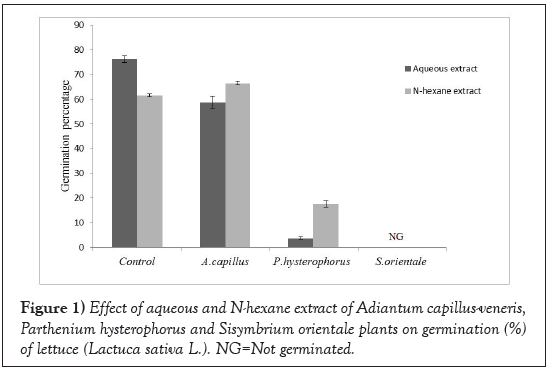
Figure 1: Effect of aqueous and N-hexane extract of Adiantum capillus-veneris, Parthenium hysterophorus and Sisymbrium orientale plants on germination (%) of lettuce (Lactuca sativa L.). NG=Not germinated.
Mean Germination Time (days)
Mean germination time (MGT) indicate time spent by a crop seed to germinate or emerge and is an essential aspect of any seed germination process [23]. The significant effect of n-hexane and aqueous extracts of A. capillus-veneris, P. hysterophorus and S. orientale weed species on the mean germination time of lettuce seeds was recorded (Figure 2). The aqueous and n-hexane extract of Sisymbrium orientale totally repressed the germination of lettuce seeds. The maximum mean germination time (6 days in n-hexane and 5.1 days in aqueous extract) was observed when lettuce seeds were treated with Adiantum capillus-veneris extracts while minimum mean germination time was noted with the application of Parthenium hysterophorus extracts. Moreover, n- hexane extraction method resulted in more phytotoxicity of both weeds (A. capillus-veneris, P. hysterophorus) than aqueous extracts. A complete inhibition of lettuce seed germination was noted with the application of aqueous and n-hexane extract of Sisymbrium orientale was probably due to more toxicity of metabolites present in its extract. This variation in the inhibitory effect of n-hexane and aqueous extracts was probably due to the variable extraction of allelochemicals by the two extraction methods. Results are supported by Bangarwa et al. [24] who reported that plants of Brassicaceae family synthesize secondary compounds called isothiocyanates (ITCs) which act as excellent natural herbicides. Furthermore, inhibitory effect of Papever orientale whole plant leachates on germination of jute seed was also reported by Mukherjee et al. [25].
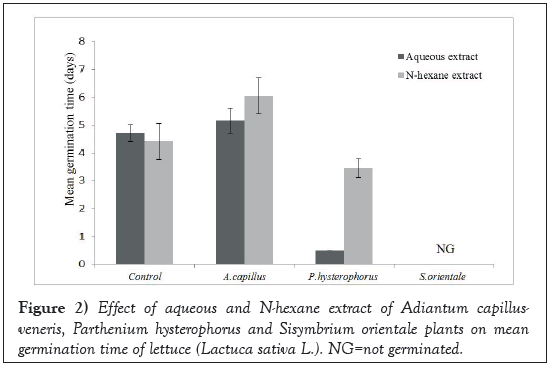
Figure 2: Effect of aqueous and N-hexane extract of Adiantum capillus-veneris, Parthenium hysterophorus and Sisymbrium orientale plants on mean germination time of lettuce (Lactuca sativa L.). NG=not germinated.
Time taken to 50% germination (days)
Time taken to 50% (T50) germination specifies the time required to complete 50% of final/maximum germination of any plant species seed and is an indicator of variance in the germination rate [26]. It has been observed that seeds exposed to extract having more phytotoxic properties require more period to attain 50% germination, so it’s a good measure of the phytotoxic potential of applied plant extracts. The aqueous and n-hexane extract of Sisymbrium orientale totally repressed the germination of lettuce seeds. The maximum time taken to 50% germination (5.34 and 5.66 days with n-hexane and aqueous extract, respectively) was observed when seeds were treated with Adiantum capillus-veneris extracts while minimum (0.37 and 3.06 days with n-hexane and aqueous extract, respectively) time taken to 50% germination was noted in Parthenium hysterophorus extracts. N-hexane extracts of both weeds (A. capillus-veneris, P. hysterophorus) were more phytotoxic than aqueous extracts. A complete inhibition of lettuce seed germination noted with the application of aqueous and n-hexane extract of Sisymbrium orientale was probably due to more toxicity of metabolites present in its extract. The increase in 50 as a result of lettuce seed treatment with Adiantum capillus- veneris extracts indicate a significant inhibition or delay of germination which was probably due to more allelopathic potential [22]. Islam and Kato-Noguchi [27] also reported a similar increase in time taken to 50% germination of cress (Lepidium sativum), lettuce (L. sativa), alfalfa (Madicago sativa), Italian ryegrass (Lolium multiflorum), barnyard grass (Echinochloa crus- galli), and timothy (Phleum pratense) seeds when they were exposed to Ocimum tenuiflorum extracts (Figure 3).
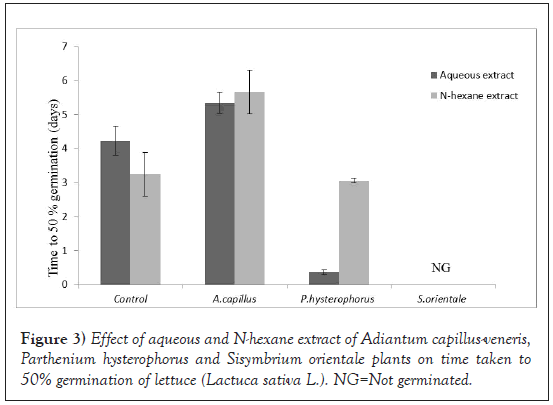
Figure 3: Effect of aqueous and N-hexane extract of Adiantum capillus-veneris, Parthenium hysterophorus and Sisymbrium orientale plants on time taken to 50% germination of lettuce (Lactuca sativa L.). NG=Not germinated.
Germination index
The germination index (GI) is the analysis method that best describes the germination percentage/speed relationship [28]. The effect of Sisymbrium orientale, Parthenium hysterophorus, and Adiantum capillus-veneris extracts on lettuce seed germination index was significant (Figure 4). The aqueous and n-hexane extract of Sisymbrium orientale totally repressed the germination of lettuce seeds. The maximum germination index (5.27 days with n-hexane and 5.43 days with aqueous extract) was observed when seeds were treated with Adiantum capillus-veneris extracts followed by Parthenium hysterophorus while minimum germination index was noted in control treatment. Moreover, between extraction methods, P. hysterophorus n-hexane extract showed more herbicidal activity than aqueous extract, while aqueous extracts of A. capillus-veneris showed more phytotoxicity than n-hexane. A significant increase in the GI of lettuce with the application of Adiantum capillus-veneris extract indicates that this extract had a stimulatory effect on lettuce seed germination. This stimulatory effect of Adiantum capillus-veneris extract might be due to the low concentration of secondary metabolites in its extract, so they stimulated the germination process. Our results are in line with the findings of Islam and Kato-Noguchi [27], who found that Ocimum tenuiflorum plant extract significantly influenced lettuce germination index. Moreover, Liu et al. [29] also reported that water extract of cumin at 10 and 20 g/L had no effects on cottonseed germination index, but at higher concentration (40 g/L and 60 g/L) it significantly inhibited germination of the cotton seed.
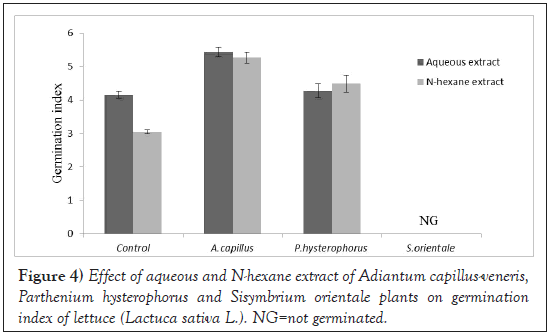
Figure 4: Effect of aqueous and N-hexane extract of Adiantum capillus-veneris, Parthenium hysterophorus and Sisymbrium orientale plants on germination index of lettuce (Lactuca sativa L.). NG=not germinated.
Lettuce shoots length (cm)
The significant effect of weed species extracts on shoot length (cm) of lettuce seedling is given in Figure 5. The aqueous and n-hexane extract of S. orientale totally inhibited the germination of lettuce seeds so there were no seedlings to measure shoot length. The minimum shoot Length (0.92 cm) was observed when seeds were treated with n-hexane extract of P. hysterophorus. This variation in the inhibitory effect of n-ehexane and aqueous extracts was probably due to the variable extraction of allelochemicals by the two extraction methods. Salam and Kato-Noguchi [30] reported that extraction of allelochemicals by using water and organic solvents is different. Moreover, Rob and Kato-Noguchi [31] reported that increasing concentration of Garcinia pedunculata extract proportionately inhibited the growth of lettuce and rapeseed.
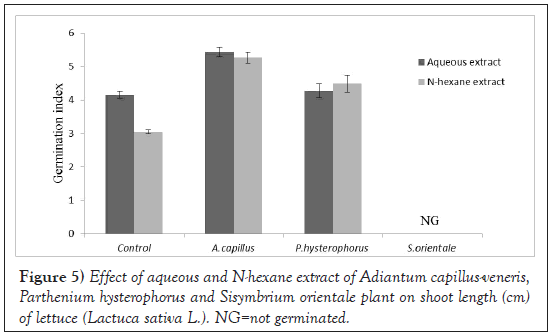
Figure 5: Effect of aqueous and N-hexane extract of Adiantum capillus-veneris, Parthenium hysterophorus and Sisymbrium orientale plant on shoot length (cm) of lettuce (Lactuca sativa L.). NG=not germinated.
Lettuce root length (cm)
More the root length more will be the seedling vigor. The data shown in (Figure 6) indicates that the effect of different extracts on lettuce seedling root length was significant. The aqueous and n-hexane extract of Sisymbrium orientale completely inhibited the development of lettuce seedlings. It was observed that lettuce seedlings treated with aqueous and n-hexane extract of Parthenium hysterophorus produced 0.17 and 3.22 cm root length, respectively. Lettuce seedlings treated with distilled water control showed intermediate root length. Maximum root length (5.47 cm) was observed with the application of Adiantum capillus-veneris n-hexane extract. A significantly different effect of n-hexane and aqueous extract on lettuce root length was also noted. The aqueous extract Parthenium hysterophorus was more toxic as compared to n-hexane extract. A non-significant difference between n-hexane and aqueous extract of Adiantum capillus-veneris on lettuce root length was observed. A complete inhibition of lettuce root length observed with the application of aqueous and n-hexane extract of Sisymbrium orientale might be due to more toxicity of allelochemicals present in its extract. These findings are confirmed by Jiang et al. [32] who found that the water extract of onion bulbs at 60 g/L concentration decreased the cotton root and shoot height. The effects of onion extracts at low concentrations (10 and 20 g/L) on cotton seedlings were stimulatory positive, but at high concentrations (40 and 60 g/L) were inhibitory.
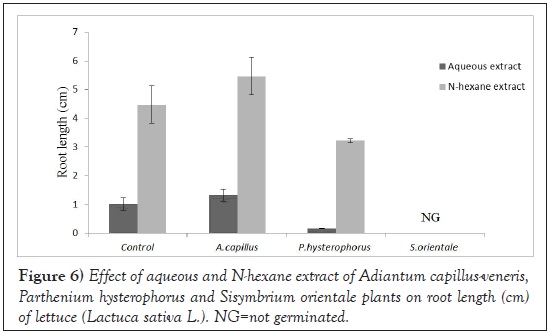
Figure 6: Effect of aqueous and N-hexane extract of Adiantum capillus-veneris, Parthenium hysterophorus and Sisymbrium orientale plants on root length (cm) of lettuce (Lactuca sativa L.). NG=not germinated.
Seedling fresh weight (mg)
Fresh weight of seedling is an indicator of normal or restricted growth. The Significant effect of weed species extracts on seedling fresh weight of lettuce seedling were recorded (Figure 7). It was noted that seeds treated with aqueous and n-hexane extract of Adiantum capillus-veneris produced 0.05 and 0.14 mg fresh weight seedling-1, while maximum seedling fresh weight (0.44 mg seedling-1) was observed in case of Parthenium hysterophorus aqueous extract. A significantly different effect of n-hexane and aqueous extract on lettuce seedling fresh weight was also noted. The aqueous extract of A. capillus-veneris was more toxic as compared to n-hexane extract. Maximum reduction in lettuce seedling fresh weight observed with the application of n-hexane extract of Parthenium hysterophorus was probably due to more toxicity of allelochemical present in its extract. Our observations are supported by Sanderson et al. [33] who described that jatropha leaves extract at 15% concentration significantly suppressed the growth and germination of radicular and aerial part of the lettuce. Javaid et al. [34] described that methanol and aqueous extracts significantly inhibited the root and shoot biomass parthenium plants.
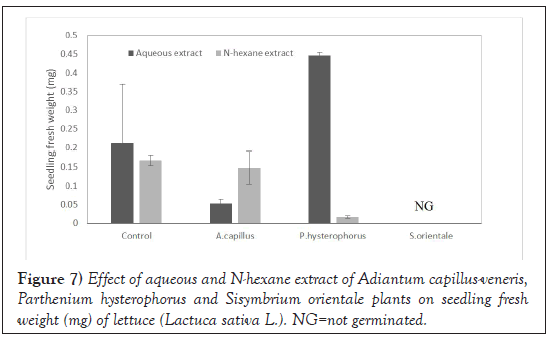
Figure 7: Effect of aqueous and N-hexane extract of Adiantum capillus-veneris, Parthenium hysterophorus and Sisymbrium orientale plants on seedling fresh weight (mg) of lettuce (Lactuca sativa L.). NG=not germinated.
Seedling dry weight (mg)
The statistically significant impact of different weed species extracts on lettuce seedling dry weight was observed (Figure 8). The aqueous and n-hexane extract of Sisymbrium orientale completely inhibited the germination of lettuce seeds; hence there was no seedling to record dry weight. Lettuce seedlings treated with aqueous and n-hexane extract of Parthenium hysterophorus resulted in 0.004 mg seedling-1 and 0.001 mg seedling-1 dry weight, respectively. Lettuce seedlings treated with distilled water showed intermediate seedling dry weight. Maximum lettuce seedling dry weight was observed with the application of aqueous and n-hexane extract of Adiantum capillus-veneris. A significantly different effect of n-hexane and aqueous extract on lettuce seedling dry weight was also noted. The aqueous extract Parthenium hysterophorus was inhibitorier as compared to n-hexane extract. A non-significant difference between n-hexane and aqueous extract of Adiantum capillus-veneris on lettuce seedling dry weight was observed. Maximum reduction in lettuce seedling dry weight observed with the application of n-hexane extract of Parthenium hysterophorus was probably due to more toxicity of allelochemicals present in its extract. The observation of Gulzar et al. [35] support our findings because they found that root and shoot lengths, dry and fresh weights of Portulaca oleracea plants reduced with the application of Asphodelus microcarpus root extract. Our findings are contradictory to the observations of Tanveer et al. [36] who reported that aqueous extract of Euphorbia dracunculoides suppressed the shoot and root dry weight of chick pea and wheat.
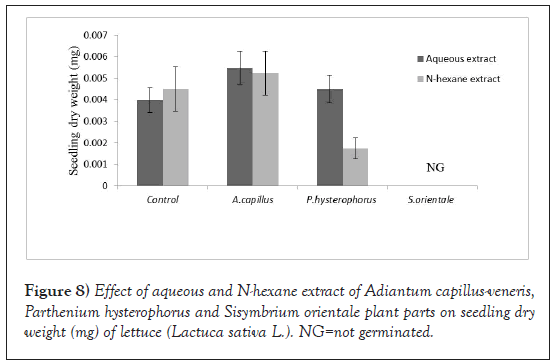
Figure 8: Effect of aqueous and N-hexane extract of Adiantum capillus-veneris, Parthenium hysterophorus and Sisymbrium orientale plant parts on seedling dry weight (mg) of lettuce (Lactuca sativa L.). NG=not germinated.
This work represents the allelopathic activity of three plant species namely Adiantum capillus-veneris, Parthenium hysterophorus and Sisymbrium orientale against germination and seedling growth of lettuce. It is concluded that S. orientale extract have comparatively more active substances with ability to suppress germination and growth of plants which could be exploited as prospective source of bio-herbicides. The results also provide evidence that N-hexane extraction method is better than aqueous extraction for evaluation of herbicidal potential of plant species.
Citation: Aziz A, Asif M, Munawar A, et al. Exploring the herbicidal potential of some weed species by using two distinct extraction methods. AGBIR. 2021;37(1):88-92.
Received: 23-Dec-2020 Accepted: 06-Jan-2021 Published: 20-Jan-2021, DOI: 10.35248/0970-1907.21.37.88-92
